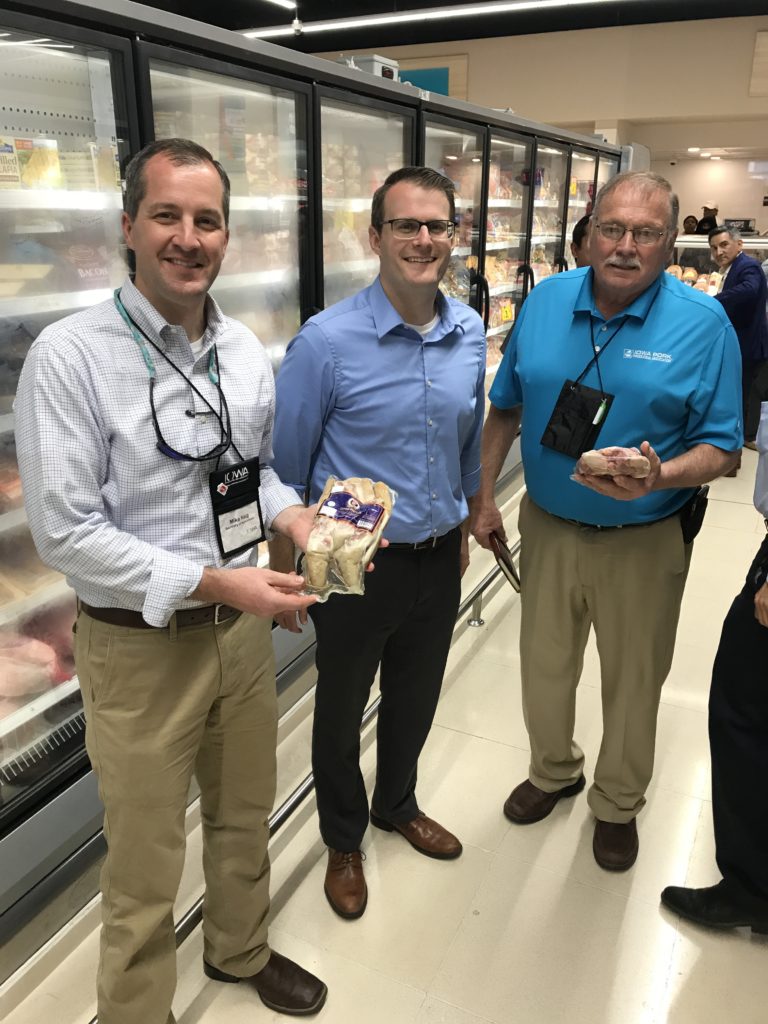Part 1 – Local Pork Industry Contributes To Local Economy
(Le Mars) — October is Pork Month, and in an effort to call more attention to the economic impact of the pork industry to the state’s economy, the Iowa pork producers Association recently released an economic study. The state’s pork producers organization shows the impact on the state, as well as with 20
individual counties, including Plymouth, Sioux, and Woodbury counties. Iowa leads the nation in pork production with more than 24 million head of hogs, and overshadows both North Carolina and Minnesota, the next two leading hog producing states, by more than ten million head. Bill Tentinger is a Plymouth County pork producer, and a former state president, as well as a current director with the National Pork Board.
Tentinger explains the study conducted by the state’s pork producer organization.
Hog production has a prominent position within northwest Iowa. Sioux County ranks second in the state with pork production with 1.3 million head of hogs, and Plymouth County holds down the fifth spot raising 1.0 million head. Lyon County is in between as the third largest county in Iowa with the number of hogs at 1.1 million head. Tentinger says the trend has shown a continued
growth in pork production.
Focusing our attention only with Plymouth County, Tentinger says there are 180 hog farms within our county with 1,552 jobs created because of the county’s pork industry.
Tentinger says in Sioux County the pork industry is responsible for nearly $300 million dollars in household income, and more than 4,000 jobs. Hogs raised in Plymouth County will consume approximately 112,000 acres of corn, and 82,500 acres of soybeans.
We will continue our series of reports focusing on the economic impact of the pork industry with future news updates.
Part 2 — Pork Exports On The Rise
(Le Mars) — We continue our series focusing on the pork industry during this October Pork Month. Several of Iowa pork producer leaders, including Plymouth County pork producer, and past state president Bill Tentinger, have participated in trade industry tours to foreign nations. Tentinger, who now serves as Iowa’s representative to the National Pork Board, has gone to Japan, Columbia, Panama, South Korea, Taiwan, Philippines, Nicaragua, Guatemala, and Mexico.
Tentinger says participating on trade industry tours is important to establish relationships with potential buyers of U-S pork products.
Tentinger points to Japan as an example of how U-S pork exports have increased over the years as a result of business relations through trade missions.
It was only a couple of decades ago that one of every 20 head of hogs raised in the United States was slated for export purposes. Today, that number has jumped to one of every four head of hogs is destined to a foreign market.
Tentinger, far right, is shown with Iowa Secretary of Agriculture, Mike Naig, far left, and Iowa Lieutenant Governor, Adam Gregg as they look at U-S pork products at a Columbia grocery store during a trade mission to Central America in 2019. (photo contributed.)
The Plymouth County pork producer says our international buyers of pork products certainly are familiar with northwest Iowa.
Pictured are members of an Iowa Trade Team Mission representing various farm organizations standing at the Panama Canal, in February of 2019. (photo contributed.)
Tentinger talks about the growth and increases with U-S pork exports.
In our final report focusing on the pork industry, we will learn about the efforts of the producer invested pork check-off, and how the collected money is responsible for the promotion, education, market development and research of hogs and pork products.
Part 3 – Producer Invested Pork Check-off Helps Stimulate Demand
(Le Mars) — Today, we conclude our three-part series focusing on the local pork industry. With earlier reports we learned about how the pork industry plays a significant role in the local economy, and exports of U-S hogs and pork products have been on the increase during the last few years. In this
report, we will focus our attention on the pork check-off program. Every time a pork producer markets their hogs, they make a contribution amounting to 40 cents for every $100 of value. The program is referred to as the “pork check-off.”
Consumers may recall the check-off promotion campaign slogan,
“Pork the Other White Meat” that was used by pork producers for several years, as a way to encourage people to eat more pork products.
Bill Tentinger is a Plymouth County pork producer and a past president of the Iowa Pork Producers Association. Tentinger now serves as a representative from Iowa on the National Pork Board, which is the governing body of producers and industry officials that supervise and oversee the collection and allocation of the pork check-off funds. Tentinger explains the money from the check-off can only be used to help finance four different programs.
Tentinger is pictured with his wife Joan, as they were awarded the honor of “Master Pork Producers” during last year’s Iowa Pork Congress.
According to Tentinger, one area how the check-off funds are being utilized is to improve the flavor of pork products, thereby making pork more desirable among consumers.
The COVID-19 virus has certainly interrupted everyone’s lifestyle, but Tentinger says because of the virus, more people are needing to stay home and cook, and as a result, domestic pork demand has increased.
Tentinger says as a result of the producer invested check-off program, pork exports have risen, and consumer demand in food services, such as schools and hospitals are higher, along with fast-food, and high-end scale restaurants are featuring more pork-related items as part of their menus.



















